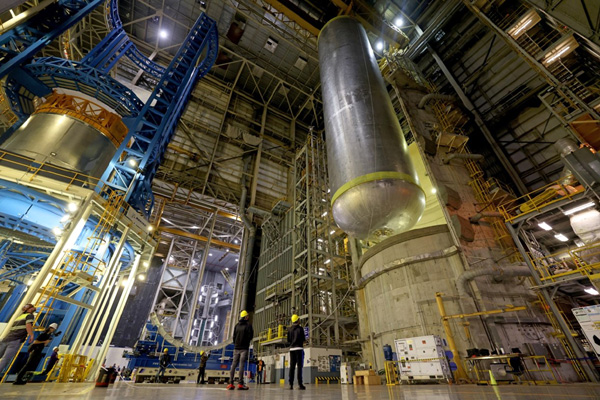
NASA / Michael DeMocker
Rocket Propellant Tanks for NASA’s Artemis III Mission Take Shape (News Release - February 16)
As NASA works to develop all the systems needed to return astronauts to the Moon under its Artemis campaign for the benefit of all, the SLS (Space Launch System) rocket will be responsible for launching astronauts on their journey. With the liquid oxygen tank now fully welded, all of the major structures that will form the core stage for the SLS rocket for the agency’s Artemis III mission are ready for additional outfitting.
The hardware will be a part of the rocket used for the first of the Artemis missions planning to land astronauts on the Moon’s surface near the lunar South Pole. Technicians finished welding the 51-foot liquid oxygen tank structure inside the Vertical Assembly Building at NASA’s Michoud Assembly Facility in New Orleans on January 8.
The mega rocket’s other giant propellant tank – the liquid hydrogen tank – is already one fully-welded structure. NASA and Boeing, the SLS core stage lead contractor, are currently priming the tank in another cell within the Vertical Assembly Building area called the Building 131 cryogenic tank thermal protection system and primer application complex.
The liquid hydrogen tank completed internal cleaning on November 14.
Manufacturing hardware is a multi-step process that includes welding, washing, and, later, outfitting hardware.The internal cleaning process is similar to a shower to ensure contaminants do not find their way into the stage’s complex propulsion and engine systems prior to priming.
Once internal cleaning is complete, primer is applied to the external portions of the tank’s barrel section and domes by an automated robotic tool. Following primer, technicians apply a foam-based thermal protection system to shield it from the extreme temperatures that it will face during launch and flight while also regulating the super-chilled propellant within.
“NASA and its partners are processing major hardware elements at Michoud for several SLS rockets in parallel to support the agency’s Artemis campaign,” said Chad Bryant, acting manager of the Stages Office for NASA’s SLS Program. “With the Artemis II core stage nearing completion, the major structural elements of the SLS core stage for Artemis III will advance through production on the factory floor.”
The two massive propellant tanks for the rocket collectively hold more than 733,000 gallons of super-chilled propellant. The propellant powers the four RS-25 engines and must stay extremely cold to remain liquid.
The core stage, along with the RS-25 engines, will produce two million pounds of thrust to help launch NASA’s Orion spacecraft, astronauts and supplies beyond Earth’s orbit and to the lunar surface for Artemis III. SLS is the only rocket that can send Orion, astronauts and supplies to the Moon in a single launch.
Through Artemis, NASA will send astronauts—including the first woman, first person of color, and first international partner astronaut—to explore the Moon for scientific discovery, economic benefits, and to build the foundation for a crewed mission to Mars. SLS is part of NASA’s backbone for deep space exploration, along with the Orion spacecraft, exploration ground systems, advanced spacesuits and rovers, Gateway and human landing systems.
Source: NASA.Gov
****

No comments:
Post a Comment